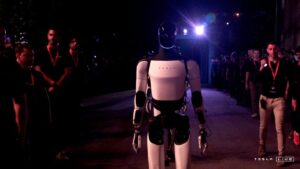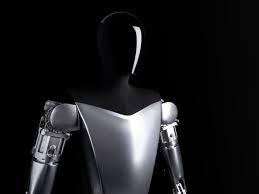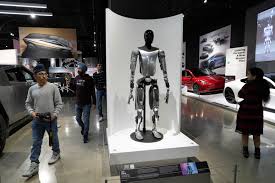Business
TESLA UNVEILS OPTIMUS ROBOT: ELON MUSK CLAIMS ‘BIGGEST PRODUCT EVER’ WITH EVERYDAY HUMAN TASK CAPABILITIES.
Tesla unveils the Optimus humanoid robot and new Robovan vehicle, showcasing a vision for robots to assist with everyday human tasks.

Elon Musk’s Tesla has recently launched its highly anticipated Optimus robot, a humanoid robot designed to perform a variety of tasks in both industrial and domestic environments. This ambitious project aims to revolutionize automation and human-robot interaction, showcasing advancements in AI, robotics, and machine learning.
**Key Features of the Optimus Robot**
1. Humanoid Design: The Optimus robot stands approximately 5 feet 8 inches tall and weighs around 160 pounds. Its humanoid form is designed to navigate environments built for humans, enhancing its ability to interact with existing infrastructure.
2. AI and Machine Learning: At the core of Optimus is Tesla’s AI technology, which has been honed through years of developing autonomous vehicles. The robot can learn from its environment, adapt to new tasks, and improve over time through machine learning algorithms.
3. Versatile Functionality: Optimus is designed to perform a range of tasks, from basic household chores to more complex industrial applications. Initial demonstrations included lifting boxes, assembling parts, and even delivering items within a controlled environment.
4. User Interface: The robot features an intuitive interface, allowing users to easily set tasks and interact with it. Voice commands and a simple app control system make it accessible for everyday use.
**Pricing Information**

Tesla has announced that the starting price for the Optimus robot is set at **$20,000**. This pricing reflects the advanced technology and capabilities integrated into the robot, making it accessible for businesses and potential home users alike. Tesla plans to evaluate market response and potentially adjust pricing as production scales.
**Applications and Use Cases**

1. Manufacturing: Optimus robots can be integrated into manufacturing lines, performing repetitive tasks with precision and efficiency. This could significantly reduce labor costs and increase productivity.
2. Healthcare: In healthcare settings, Optimus could assist with logistics, such as delivering supplies or helping with patient care in non-critical situations, freeing up staff for more essential tasks.
3. Home Assistance: For domestic use, Optimus is envisioned as a helper for chores like cleaning, cooking, and even providing companionship.
4. Logistics and Delivery: The robot’s ability to navigate various environments makes it suitable for warehouse operations and last-mile delivery services.
**Challenges and Considerations**

Despite its promising features, the Optimus robot faces several challenges:
– Technical Limitations: While the robot can perform basic tasks, more complex scenarios require further development. Real-world applications will need rigorous testing and refinement.
– Safety Concerns: Ensuring that Optimus operates safely around humans is paramount. Tesla is focused on implementing advanced safety protocols to minimize risks.
– Market Readiness: The commercial viability of the Optimus robot will depend on production costs and market demand. Tesla plans to evaluate various industries for potential adoption.
**Future Developments**

Musk has indicated that Tesla aims to produce a fleet of Optimus robots, scaling up operations based on demand and technological advancements. Future iterations may include enhancements in mobility, dexterity, and AI capabilities, allowing for greater autonomy and functionality.
**Conclusion**

The launch of Tesla’s Optimus robot marks a significant step forward in the field of robotics and AI. While still in the early stages, the potential applications across various sectors are immense. As the technology evolves, Optimus could play a crucial role in transforming industries and everyday life, aligning with Musk’s vision of a future enhanced by intelligent automation.
